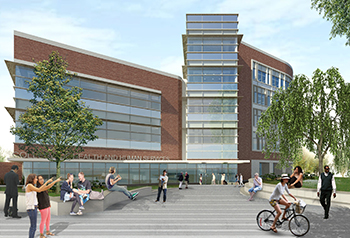George Mason to Construct Health Sciences Building
 FAIRFAX, Va. — George Mason University (GMU) broke ground this summer on a new $73 million health sciences building to debut in 2017. The 160,000-square-foot Academic VII/Research III building is part of GMU’s ongoing strategic plan, which includes renovating several academic buildings. New York-based Perkins Eastman is serving as the architect on the project.
FAIRFAX, Va. — George Mason University (GMU) broke ground this summer on a new $73 million health sciences building to debut in 2017. The 160,000-square-foot Academic VII/Research III building is part of GMU’s ongoing strategic plan, which includes renovating several academic buildings. New York-based Perkins Eastman is serving as the architect on the project.
The main goal of the project is to create a new facility for GMU’s College of Health & Human Services, which is currently located in an aging, undersized building and needs to consolidate its growing program in a larger, dedicated facility that will be seen as a model for future campus buildings, according to Stephen Penhoet AIA, LEED AP, associate principal and project manager for Perkins Eastman. The university is also dramatically short of correctly sized and equipped classrooms, and Academic VII will incorporate numerous classrooms that support the latest theories and techniques in current teaching methods. The building and its surrounding site development is also key in completing a new north gateway as part of the new North Sector Master Plan for the Fairfax campus. Once Health and Human Services vacates its current buildings (located in the heart of the campus), the university will either fully rehabilitate or replace them.
“The building’s overall massing defines a new, formal entry to the university from the north and features a courtyard that faces the oldest parts of the campus to the south,” Penhoet said. “Additionally, the proportions of the building reflect best sustainability practices and allow for the most advantageous solar exposure. The interior is organized along an east-west spine that promotes formal and informal interaction between students, faculty and staff and allows for views to the adjacent open green space.”
There are a variety of uses in the building including student administration, classrooms, offices, laboratories, medical clinical suites, a cafe and teaching kitchens. It also features heights — at two-, three- and five-story sections — that house diverse program elements, providing variety in the overall massing as well as creating separate, identifiable entries and uses.
The design process involved many more stakeholders, users and facilities managers than one would find in a typical higher education facility, and the programming effort of interviews, space planning and owner coordination was detailed and lengthy, according to Penhoet. The project is also unusual in that the building advances sustainable design aspects from what had been proposed in Perkins Eastman’s Master Plan for the new North Sector by adjustments in orientation, glazing and material palette. Additionally, the design establishes a new, large outdoor courtyard designed for informal study, group gatherings and university events.
“The review process by all of the stakeholders was very thorough, and students, faculty and staff were invited to comment on the program and design during the early phases,” Penhoet said. “In general, the entire university community is excited about the prospect of a new, state-of-the-art facility that will enhance and define a new front door for the Fairfax campus and will set a new standard for sustainability, flexibility and long-term value.”
